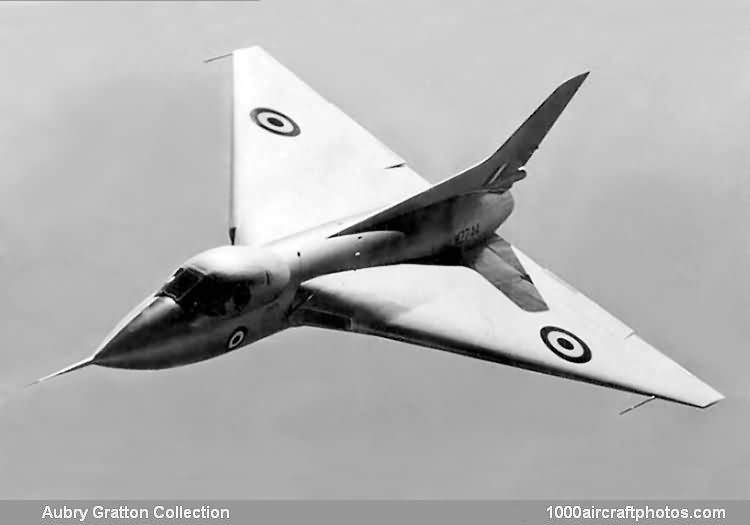09/30/2012. Remarks by Johan Visschedijk: "The Avro 707 was a small delta wing research monoplane powered by a single Rolls-Royce Derwent turbojet, built in 1949 to provide data for the Avro 698 Vulcan. It was a single-seater of all-metal, stressed skin construction with sharply tapering mainplane and a dorsal engine air intake faired into a swept fin. Control was by normal rudder combined with four control surf aces hinged to the trailing edge of the wing, the inboard pair acting as elevators and the outers as ailerons. Retractable air brakes were provided above and below the wing, and the cockpit canopy was from a Gloster Meteor.
With serial VX784, the Avro 707 was first flown at the RAE at Boscombe Down on September 4, 1949 by Avro test pilot S.E. 'Red' Esler who spent the next day putting in sufficient flying for the 707 to qualify for inclusion in that year's SBAC Show. He flew it to Farnborough for static exhibition on September 6 but during a test flight on September 30, crashed near Blackbushe and was killed.
A second aircraft, Avro 707B (s/n VX790), intended for research into the low speed stability characteristics of delta wings, was first flown at Boscombe Down on September 6, 1950 by Avro Chief Test Pilot R.J. Falk. Basically similar to the ill-fated Avro 707, the 707B was also Derwent powered but incorporated a wing having 51° of leading edge sweep-back. To speed construction it used an Avro Athena main landing gear and a Hawker P.1052 nose wheel leg lengthened by 9 in (0.23 m) to give sufficient take off incidence. It proved an outstandingly docile aeroplane which completed 100 hours of research flying at Dunsfold before going to Boscombe Down in September 1951. It was used for general research duties with the Royal Aircraft Establishment (RAE) and the Empire Test Pilots School (ETPS).
Although nominally a 'low speed' aircraft, the Avro 707B had been flown fast enough for the canopy to set up turbulence around the dorsal air intake and to cause partial starvation of the engine. The third delta aircraft, designated Avro 707A (s/n WD280), was consequently built with wing root intakes, making it virtually a one-third scale model of the Vulcan. It was first flown at Boscombe Down by R.J. Falk on June 14, 1951. It was designed for operation at the highest possible subsonic speed because speeds greater than that of sound required excessive engine power as well as power operated controls.
Later it was used as test vehicle for the compound sweepback modification subsequently built into the leading edge on all Vulcans. In 1958 it was shipped to Australia for investigations into airflow over delta wings at low speed by the Aeronautical Research Laboratories of the Department of Supply and flown from a base at Avalon, Victoria. With serial number repositioned on the nose, it was suspended from the laboratory roof for public exhibition at Avalon in February 1961 and gave a spirited flying display at the Laverton RAAF base on September 16, 1962. To speed the research program, a second Avro 707A (s/n WZ736) was built, which first flew February 20, 1953.
The 707-series was completed by a fifth aeroplane (s/n WZ744), first flown on July 1, 1953. Designated Avro 707C it was a development of the 707A seating two pilots side-by-side in a widened cockpit for familiarization purposes, and flew in formation with the three single-seaters at the 1953 SBAC Show. The Avro 707C was transferred to RAE, Bedford, for supersonic tests in 1958 and flew with an electric servo system duplicating the normal control circuits. Veteran of more than a decade of experimentation, this machine was still on the strength of the RAE, Farnborough, in 1963.
As stated, VX784 crashed in 1949, but VX790 was also involved in a serious accident and was cannibalized for spares for the remaining three 707s, which all survived. The Avro 707A (WZ736) is preserved at the Museum of Science and Industry in Manchester, UK, the Avro 707B (WD280) at the RAAF Museum in Point Cook, Victoria, Australia, while the Avro 707C (WZ744) is at the RAF Museum, Cosford near Wolverhampton, UK."
